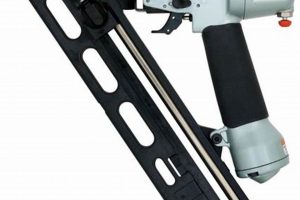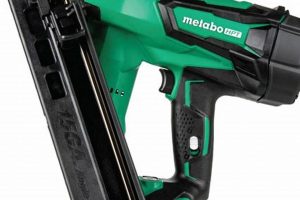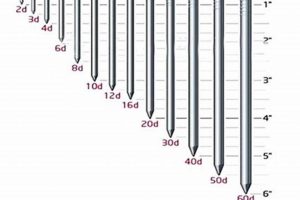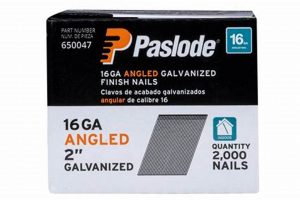These fasteners are slender, typically 15 or 16 gauge, and are designed for applications where concealment is paramount. Their small head size allows them to be driven nearly flush with the surface of the material, leaving a minimal hole that can be easily filled and finished. An example application is attaching trim to cabinets, where a clean, unblemished surface is desired.
Using these specific fasteners provides a superior aesthetic outcome compared to using larger, more prominent nails or screws. This results in a higher quality finished product, increasing its perceived value and durability. Historically, these fasteners were essential in fine woodworking and furniture construction, providing a subtle yet secure method of joining pieces together without detracting from the visual appeal.
The subsequent sections will delve into appropriate usage scenarios, alternative fastening methods, and best practices for achieving optimal results with these particular types of fasteners, highlighting techniques to minimize wood splitting and ensure secure holding power. Detailed comparisons will also be provided regarding different types of nail guns suitable for their application.
Optimizing Applications Using These Fasteners
This section provides practical guidance for achieving professional results when utilizing these slender fasteners, ensuring secure and aesthetically pleasing outcomes.
Tip 1: Employ Proper Nail Gun Settings: Adjust the depth setting on the nail gun to prevent overdriving. Overdriving damages the surrounding material and compromises holding power. Test settings on scrap material before beginning the primary task.
Tip 2: Angle the Nail Gun for Enhanced Grip: Driving the fastener at a slight angle increases the surface area of contact within the material. Angled placement enhances holding strength, particularly when joining two pieces of wood at an edge.
Tip 3: Pre-Drill Hardwoods to Avoid Splitting: Hardwoods are prone to splitting when a fastener is driven directly. Pre-drilling a pilot hole slightly smaller than the nail diameter minimizes the risk of splitting and ensures smoother insertion.
Tip 4: Space Fasteners Appropriately: Overcrowding fasteners weakens the material and increases the likelihood of splitting. Maintain sufficient spacing between fasteners to distribute stress evenly and ensure structural integrity.
Tip 5: Choose the Correct Nail Length: Select a nail length that penetrates sufficiently into the receiving material. A general guideline is to ensure the nail penetrates at least twice the thickness of the material being fastened.
Tip 6: Use Appropriate Safety Gear: Safety glasses are crucial when operating a nail gun. Wearing safety glasses can prevent injury from flying debris and misfired nails.
Tip 7: Regularly Inspect the Nail Gun: Ensure the nail gun is clean, properly lubricated, and free from obstructions. Regular maintenance prolongs the lifespan of the tool and prevents malfunctions.
Adhering to these tips optimizes the performance of these fasteners, resulting in professional-grade results with minimal surface damage and enhanced structural integrity.
The subsequent section will explore alternative fastening solutions and offer a comparative analysis to determine the most suitable method for specific applications.
1. Gauge (size)
Gauge, in the context of these fasteners, refers to the diameter of the nail shaft. This dimension critically impacts the fastener’s holding power, visibility, and suitability for various materials. Selecting the appropriate gauge ensures secure fastening while minimizing surface damage, a balance crucial for finishing applications.
- Impact on Holding Power
A larger gauge generally implies greater holding power due to the increased surface area in contact with the surrounding material. However, a larger gauge also increases the risk of splitting thinner or more delicate workpieces. Therefore, these fasteners often utilize a smaller gauge to prioritize aesthetics over maximum holding strength, relying instead on adhesive or other supporting structural elements.
- Visibility and Aesthetic Considerations
The primary advantage of these fasteners is their ability to provide nearly invisible fastening. A higher gauge (smaller diameter) allows the nail to be driven more discreetly, leaving a smaller hole that requires minimal filling and finishing. This is particularly important in trim work, cabinetry, and other applications where visual appeal is paramount.
- Material Compatibility
The gauge of these fasteners must be appropriate for the material being fastened. Softer woods may accommodate a slightly larger gauge without splitting, while harder woods often necessitate a smaller gauge or pre-drilling to prevent damage. The choice of gauge depends heavily on the density and structural characteristics of the wood.
- Compatibility with Nail Guns
The gauge determines the compatibility with specific nail guns. These fasteners are typically used with pneumatic or cordless nail guns designed to handle the appropriate gauge and length of fastener. Using the incorrect gauge can damage the nail gun or result in misfires and improper fastening.
The gauge selection for these fasteners represents a trade-off between holding power and aesthetic considerations. While a larger gauge offers increased strength, the inherent design emphasizes minimal visibility and surface disruption. Therefore, these fasteners are best suited for applications where aesthetics and a clean finish outweigh the need for maximum structural integrity. Complementary techniques, such as adhesive application or strategic fastener placement, can further enhance the overall strength of the assembly.
2. Head type
The head type of these fasteners is a critical design element that directly affects their suitability for finish work. These nails are specifically engineered to minimize visibility once driven, which necessitates a head that is either very small or easily concealed. Two common head types exist: brad heads and small, slightly flared heads, each serving the primary function of near-invisibility. Brad heads are essentially headless, offering the least visible option, while the small flared heads provide slightly more holding power due to their increased surface area. The choice between these types hinges on the specific application and the balance required between holding strength and aesthetic appeal. For instance, when attaching delicate trim where minimal damage is crucial, brad heads are preferable. Conversely, when securing slightly heavier trim where a bit more grip is needed, the flared head type may be more appropriate.
The design of these heads also directly impacts the application method. The small size means they are generally driven with a pneumatic nail gun designed for finish nails. The precision offered by these tools ensures consistent depth and minimal damage to the surrounding material. In contrast, attempting to drive these fasteners manually with a hammer can result in bent nails, damaged surfaces, and inconsistent results. Therefore, the head type effectively dictates the use of specialized tools to ensure proper installation and desired outcomes. Failures often occur when users attempt to use traditional hammers, leading to unsatisfactory finishes and compromised structural integrity.
In summary, the head type is an essential characteristic of these fasteners, determining both their aesthetic performance and the application methods they require. By prioritizing minimal visibility, the design necessitates specific tools and techniques to ensure proper installation. Understanding the implications of head type is crucial for achieving professional-grade results in woodworking and finishing projects. The choice of head affects not only the finished appearance but also the overall structural integrity of the fastened materials, emphasizing its importance in various applications.
3. Length Variety
The available range of lengths for these fasteners is a critical attribute impacting their versatility and suitability for diverse applications. The effect of choosing an inappropriate length can range from insufficient holding power to complete failure of the joint, or, conversely, protrusion of the fastener through the material, compromising the finished appearance. Proper length selection is therefore essential for both structural integrity and aesthetic quality. The importance of offering various lengths stems from the wide spectrum of material thicknesses encountered in trim work, cabinetry, and other finishing tasks where these fasteners are commonly employed. For instance, attaching thin veneer to a substrate necessitates a shorter length to prevent breakthrough, while securing thicker trim pieces requires a longer fastener to ensure adequate penetration into the underlying support structure.
Consider a scenario where an individual attempts to fasten 3/4-inch thick baseboard to a wall using fasteners that are only 1 inch in length. The limited penetration into the wall stud may result in a weak and unstable connection, prone to loosening or detaching over time. Conversely, using a 2-inch long fastener in this same application would provide a much more secure attachment. Practical application dictates that one select a length that penetrates deeply enough into the receiving material to assure a solid, durable hold. Manufacturers offer a range of lengths, often starting around 1 inch and extending up to 2 1/2 inches or more, to accommodate variations in material thickness and application requirements. The availability of various lengths empowers users to tailor their fastening approach to the specific demands of the project at hand.
In conclusion, the variety of lengths available for these fasteners addresses the practical challenges posed by differing material thicknesses. Selecting the correct length is essential to ensure adequate holding power and to prevent unwanted protrusion. While the availability of different lengths enhances the versatility of these fasteners, proper selection requires a thoughtful understanding of the materials being joined and the specific demands of the application. This understanding contributes significantly to the success and longevity of woodworking and finishing projects.
4. Material (Steel)
The material composition, specifically steel, is fundamental to the performance characteristics of these fasteners. Steel provides the necessary tensile strength and shear resistance required to securely join materials in finishing applications. The grade of steel used in their manufacture directly influences their ability to withstand bending forces during and after installation, affecting the overall longevity and reliability of the finished product. Low-carbon steel is commonly employed, often with a surface treatment, to enhance corrosion resistance.
A real-life example illustrates the significance of steel quality. Consider two identical pieces of trim, one fastened with nails made of high-quality steel and the other with nails of inferior steel. Over time, the inferior nails may corrode, weaken, or even break, leading to loose trim and potential aesthetic degradation. In contrast, the trim secured with high-quality steel nails remains firmly in place, maintaining its structural integrity and appearance. The application of coatings such as zinc or specialized polymers further protects the steel from environmental factors, increasing the fastener’s lifespan. Improper material selection can cause staining of the wood finish, a common problem in poorly manufactured products.
In summary, the choice of steel as the primary material for these fasteners is a deliberate decision based on its strength, durability, and cost-effectiveness. While variations in steel grade and surface treatment exist, selecting fasteners manufactured from high-quality steel is crucial to ensure a long-lasting and aesthetically pleasing finish. Overlooking this aspect can lead to premature failure and compromised project outcomes. Understanding the properties of the steel employed in their construction is therefore essential for professionals and DIY enthusiasts alike to ensure the long-term stability and visual appeal of their projects.
5. Applications (trim)
The relationship between these fasteners and trim applications is symbiotic; the former provides the means to securely and inconspicuously affix the latter, enabling the creation of aesthetically refined spaces. Their design directly addresses the requirements of installing trim, where both holding power and minimal visibility are paramount.
- Baseboards and Molding
These fasteners are frequently used to install baseboards and various types of molding along walls and ceilings. Their slender profile minimizes the appearance of nail holes, allowing for a smooth and polished finish after filling and painting. The choice of length is crucial, ensuring sufficient penetration into wall studs or ceiling joists while avoiding pass-through.
- Door and Window Casings
Attaching door and window casings often necessitates a delicate balance between secure fastening and aesthetic preservation. These fasteners provide this balance, allowing casings to be affixed without unsightly nail heads detracting from the overall appearance. Careful selection of nail length prevents damage to the window or door frame itself.
- Cabinet Trim and Detailing
In cabinet making, the application of trim and decorative detailing often demands fasteners that are virtually invisible. They are well-suited for this purpose, allowing for the secure attachment of trim pieces without compromising the cabinet’s aesthetic. The small diameter of the fastener minimizes the risk of splitting the wood, particularly with hardwoods.
- Furniture Finishing
Beyond architectural trim, they are also employed in furniture finishing, particularly for attaching delicate moldings or edge banding. The ability to drive these fasteners flush or slightly below the surface enables seamless integration with the furniture’s design. They provide a reliable and unobtrusive means of securing decorative elements, enhancing the overall quality and appearance of the finished piece.
The success of trim applications heavily relies on the proper selection and use of fasteners such as these. Their design caters specifically to the needs of finish work, providing a discreet and reliable means of attachment. Alternatives like screws or larger nails would compromise the aesthetic, highlighting the unique value proposition offered by these specialized fasteners in the context of trim installation.
6. Nail guns
The operation of these fasteners is intrinsically linked to the use of nail guns. These pneumatic or cordless tools provide the necessary force and precision to drive the slender nails without bending or damaging them. The nail gun serves as an essential component of the overall fastening system, ensuring consistent depth and accurate placement, both critical for achieving a clean, professional finish. Without a nail gun, consistently driving these fasteners to the correct depth while maintaining a flush surface would be exceptionally difficult and time-consuming.
The utilization of nail guns significantly expands the application possibilities for these fasteners. Consider a large-scale trim installation project, such as fitting baseboards in a new home. Manually hammering each nail would be impractical and result in inconsistent finishes. A nail gun enables rapid and precise placement of the fasteners, drastically reducing the installation time and improving the overall quality of the work. Different types of nail guns are designed for specific applications, such as angled finish nailers for tight corners or brad nailers for delicate trim work. The selection of the appropriate nail gun is therefore paramount to achieving optimal results. Furthermore, nail guns often feature adjustable depth settings, allowing users to fine-tune the driving force to match the material’s density and prevent overdriving.
In conclusion, nail guns are indispensable tools for effectively applying these fasteners. The combination of specialized nail design and the controlled power of a nail gun provides a superior fastening solution for a wide range of finishing applications. Improper application can lead to a compromised finished product. Proper nail gun functionality and maintenance are essential to avoid misfires and ensure consistent performance. The synergistic relationship between fastener and tool ensures efficient and precise installation, underlining its importance in achieving professional-quality results.
Frequently Asked Questions About 2 1 2 Finish Nails
The following addresses common inquiries concerning the application, selection, and performance characteristics of these fasteners, providing clarity for optimal usage.
Question 1: What differentiates these fasteners from standard nails?
These fasteners are distinguished by their smaller gauge and minimal head, designed to minimize visibility in finish work. Standard nails typically feature larger heads and gauges, prioritizing holding power over aesthetics.
Question 2: In what scenarios are these fasteners most appropriate?
These fasteners are ideally suited for trim work, cabinet construction, and other applications where a clean, unblemished surface is desired. They are not intended for structural applications requiring high load-bearing capacity.
Question 3: What is the optimal nail gun setting for driving these fasteners?
The depth setting on the nail gun should be adjusted to ensure the nail is driven flush with the surface without overdriving. Testing on scrap material is recommended to determine the appropriate setting.
Question 4: Can these fasteners be used in hardwoods without pre-drilling?
Pre-drilling is strongly recommended when using these fasteners in hardwoods to prevent splitting. A pilot hole slightly smaller than the nail diameter facilitates smoother insertion and minimizes the risk of damage.
Question 5: What length of these fasteners should be selected for a given application?
The fastener length should be at least twice the thickness of the material being fastened to ensure adequate penetration and holding power. Overly long nails can protrude, while shorter nails may not provide sufficient grip.
Question 6: Are there specific safety precautions to observe when using these fasteners and associated nail guns?
Eye protection is mandatory when operating a nail gun. Users should also ensure the tool is properly maintained and operated according to the manufacturer’s instructions to prevent accidents.
In summary, these fasteners offer a discreet fastening solution for applications where aesthetics are paramount. Understanding their limitations and adhering to best practices ensures optimal results.
The following section will present a comparative analysis of various fastening methods.
Conclusion
This exploration has detailed the critical attributes of 2 1 2 finish nails, encompassing gauge, head type, length variety, material composition, appropriate applications, and their dependency on nail guns. Each characteristic plays a decisive role in the fastener’s performance, directly impacting the aesthetic quality and structural integrity of finished projects.
Understanding these nuances is essential for professionals and DIY enthusiasts alike. Employing 2 1 2 finish nails effectively requires careful consideration of material properties, tool settings, and safety precautions. Mastering these elements ensures successful outcomes, solidifying the role of 2 1 2 finish nails as a reliable and indispensable component in quality finishing work. Continued adherence to best practices will ensure reliable and quality outcomes.







